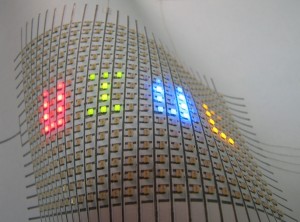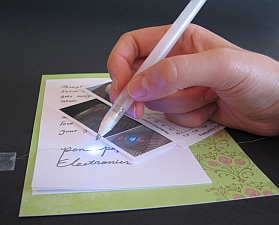Materials scientists and engineers at University of Illinois in Champaign have developed a rollerball pen (pictured left) capable of writing electrical circuits and interconnects on paper, wood, and other surfaces. The team of faculty, postdoc, and students published their findings in the online issue of the journal Advanced Materials (paid subscription required).
While it looks like a typical rollerball pen that prints in silver-colored ink, the pen’s “ink” in this case is a solution of real silver. After writing, the liquid in the ink dries to leave conductive silver pathways that act as wires mounted on the substrate. The ink maintains its conductivity through multiple bends and folds of the paper or other bendable materials, making possible devices needing flexibility and conformability.
Metallic inks have been used in inkjet printers to fabricate electronic devices, but the pen offers freedom and flexibility to apply ink directly to paper or other rough surfaces instantly, at low cost and without programming. Also, unlike inkjet printers, the pen does not use expensive ink cartridges or print heads.
The ability to use the pen to create freestyle conductive pathways enables new possibilities in art, disposable electronics, and folded three-dimensional devices. The researchers also have demonstrated a flexible LED display on paper (pictured below), conductive text and three-dimensional radio-frequency antennas.

A flexible array of LEDs mounted on paper. Hand-drawn silver ink lines form the interconnects between the LEDs. Click on image for full-size display. (Bok Yeop Ahn, University of Illinois)
* * *


 RSS - Posts
RSS - Posts
You must be logged in to post a comment.